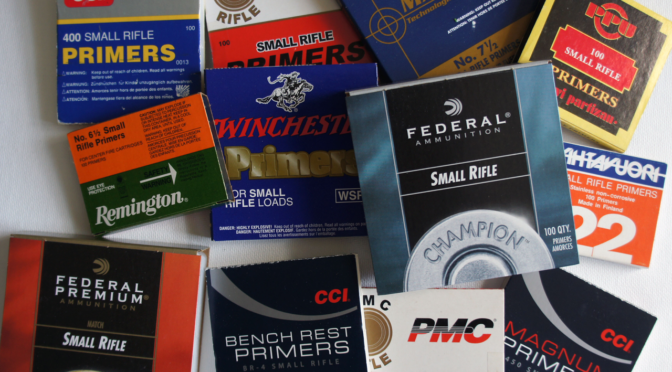We published a report on Large Rifle Primer (LRP) 308 Winchester performance in TS just over two years ago and promised a follow-up using Lapua ‘Palma’ brass and Small Rifle (SRP) caps. So, here we eventually are having done most of the range testing more than a year ago but the write-up was delayed by the late addition of a highly recommended model. Altogether, 15 primers from eight manufacturers were tried – although one was withdrawn after only a few rounds fired thanks to weak cups and consequent ‘blanking’.
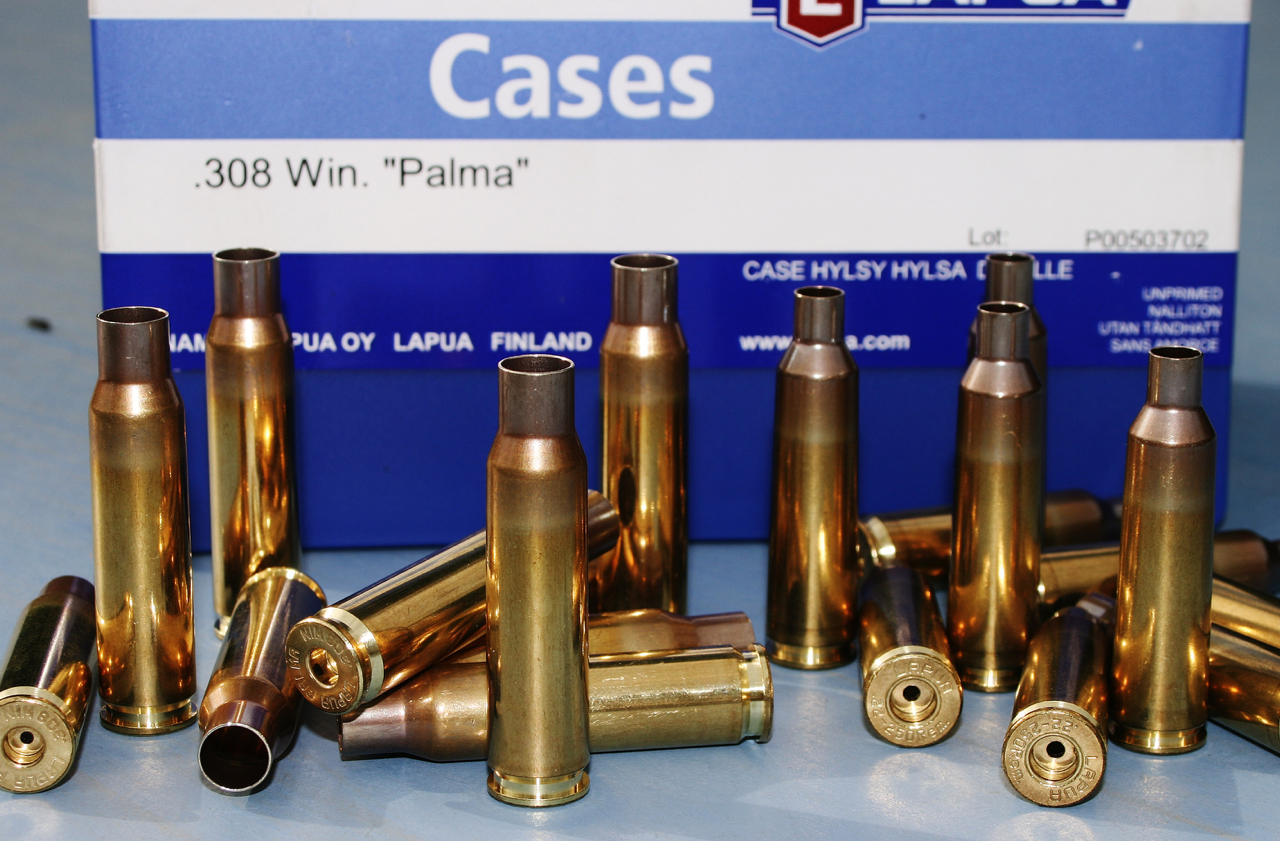
Lapua Palma small primer brass – very consistent out of the box
The primary objective was – as with Large Rifle primers – to determine how much difference product substitution makes to ballistic performance in terms of average MV, extreme spread (ES) and standard deviation (SD) figures. As before, a 308 Win calibre FTR rifle was used whose barrel was in good condition, albeit no longer in the first flush of youth, loading good quality if rather low BC 168gn bullets over a full working pressure Vihtavuori N150 single-based powder charge. Rifle aside, the other main change from the LRP tests was that whilst they used a good quality (RWS) case, the brass was out of the box without preparation or batching. This time round, the already consistent Lapua ‘Palma’ examples were weight batched, had their flash-holes ‘uniformed’, necks had been lightly turned and cases were annealed before each reloading during the series.
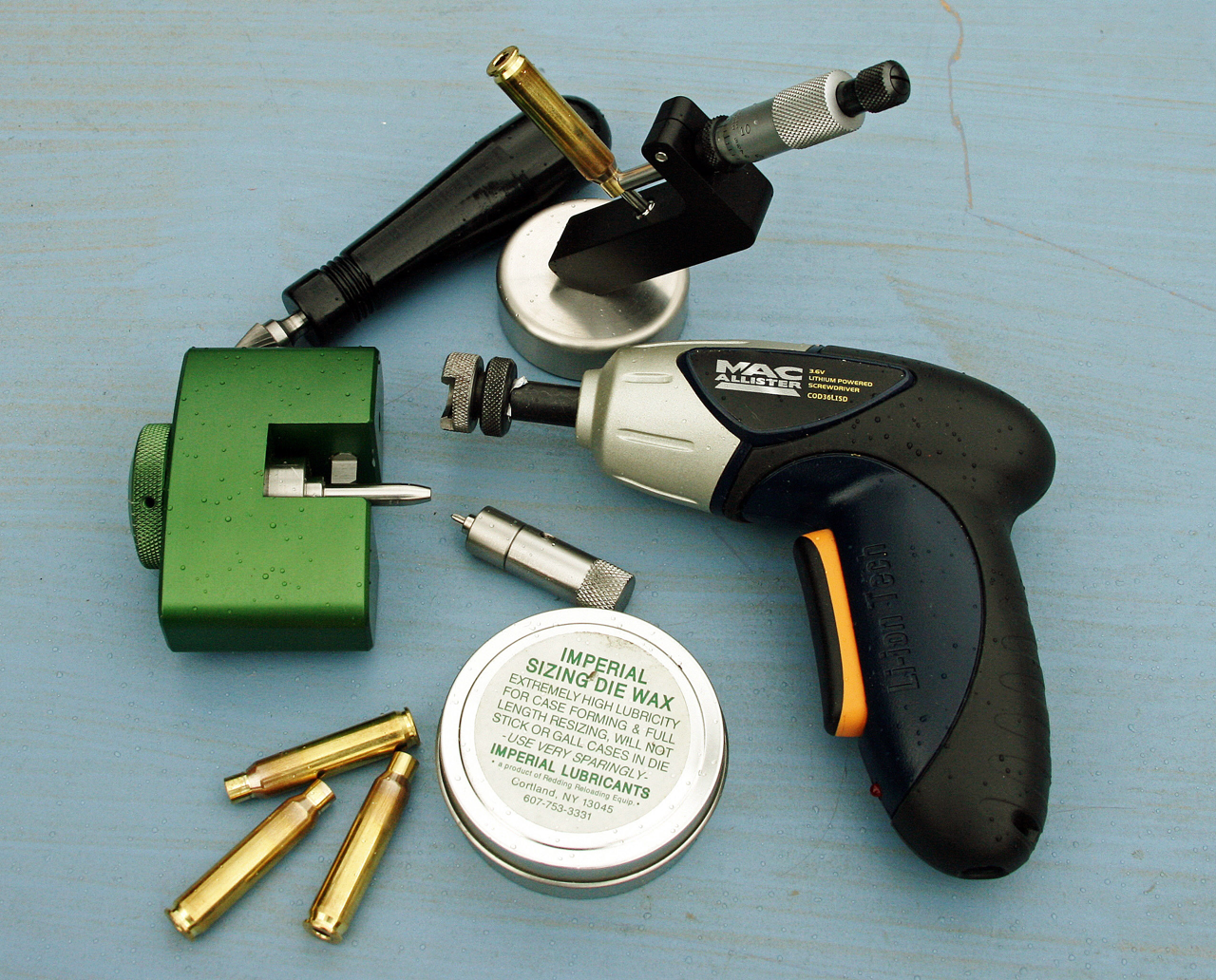
Some preparation was done on the cases – a mild neck-turn, and flash-holes ‘uniformed’ with the Sinclair reamer as with these Lapua 223 Rem examples
There were additional objectives this time around and a key difference (brass and primer type aside) from the LRP tests. The first add-on was to see how much MV change is produced by a switch from standard LRP Lapua cases to the SRP ‘Palma’ variant. This was combined with the initial loads ‘work-up’ and range test used to find a suitable charge weight for the subsequent primer substitution trials.

Lapua standard LRP and ‘Palma’ case heads, flash-holes and primers
Then, as to the claim that SRP ‘Palma’ cases reduce MV ES (extreme spread) values compared to their LRP brothers – the reason for the American Palma teams asking Lapua to produce the cases in the first place – the weight of evidence based on actual range experience and competition results is so great that few if any will question this now. I had no intention of reinventing that particular wheel. Nevertheless, with a range of SRP results available, it’s not unreasonable to refer back to the LRP tests. Yes, I know that a direct comparison cannot be made as the rifle, make of case, bullet model are different but with expectations of ES values being reduced by a full third, such a large step-change should show.
A final add-on was to ascertain differences in SR primer cup strength as, unlike in the Large Rifle type, their metal thickness varies – which models stand up to high pressures and which don’t. So, a smaller secondary test series using my FTR 155.5gn Berger and IMR-8208 XBR load was carried out without the MagnetoSpeed attached as the intention was to see if group patterns/sizes changed much as a result of primer substitution alone; secondly, whether a selection of six models that had performed well in ES/SD terms in the 167gn bullet tests would endure a full pressure loading that probably exceeds 60,000 psi.
Rationales
Returning to basics, why does one want smaller velocity spreads? Smaller groups presumably? Actually no, or at least not directly – a load giving a tiny low single figure ES value might be allied to horrible groups as it is bullet–to–barrel compatibility and action-barrel harmonics that largely determine ‘precision’ as defined in short-range group sizes. We attempt to achieve ES minimisation alongside necessary precision, particularly for long-range shooting. As we’re talking about the 308 Winchester, it has been the primary cartridge in ‘Target Rifle’, ‘Palma’, ‘Fullbore Rifle’ for a half century, more recently ‘Match Rifle’ and FTR. Here in the UK, unlike North America, it is not so much the primary cartridge as the nearly exclusive one, the other eligible number (223 Remington) seeing little use in high-level competition.
‘Long-range’ is defined as beyond 600 yards. In practice, we really mean shooting at 800, 900 and 1000 yards (1000 to 1200 for Match Rifle) at which distances the 308 is close to the limits of its ballistic comfort zone. Cartridges with a large MV spread shot at a target a half-mile or more away produce velocity-induced (as opposed to group shape influenced) vertical dispersions, whilst the Holy Grail for competitors is a rifle/ammunition combination that eliminates this occurrence. That is, if correctly zeroed for the distance, shots will lie along a horizontal line through the centre of the V-Bull, referred to as being ‘on the waterline’ by competitors and wind coaches.
The reason for this is that when shooting at circles – as we do in traditional deliberate prone disciplines – the best chance of minimising wind change induced effects on the score-value is to keep all shots on the 3 to 9 o’clock axis where the ring is at its widest. If a shot taken with a good wind call strikes a Minute of Angle high or low on the international ICFRA Fullbore target with its 2-MOA 5-ring diameter, (half that for the F-Class equivalent), it needs absolutely correct windage to break the line and avoid dropping a point but, any misread of the wind or other lateral deviation at all guarantees that outcome. Conversely, if the shot is ‘on the waterline’, the shooter gains a full MOA latitude to each side of the Fullbore target’s exact centre, (half that for F-Class).
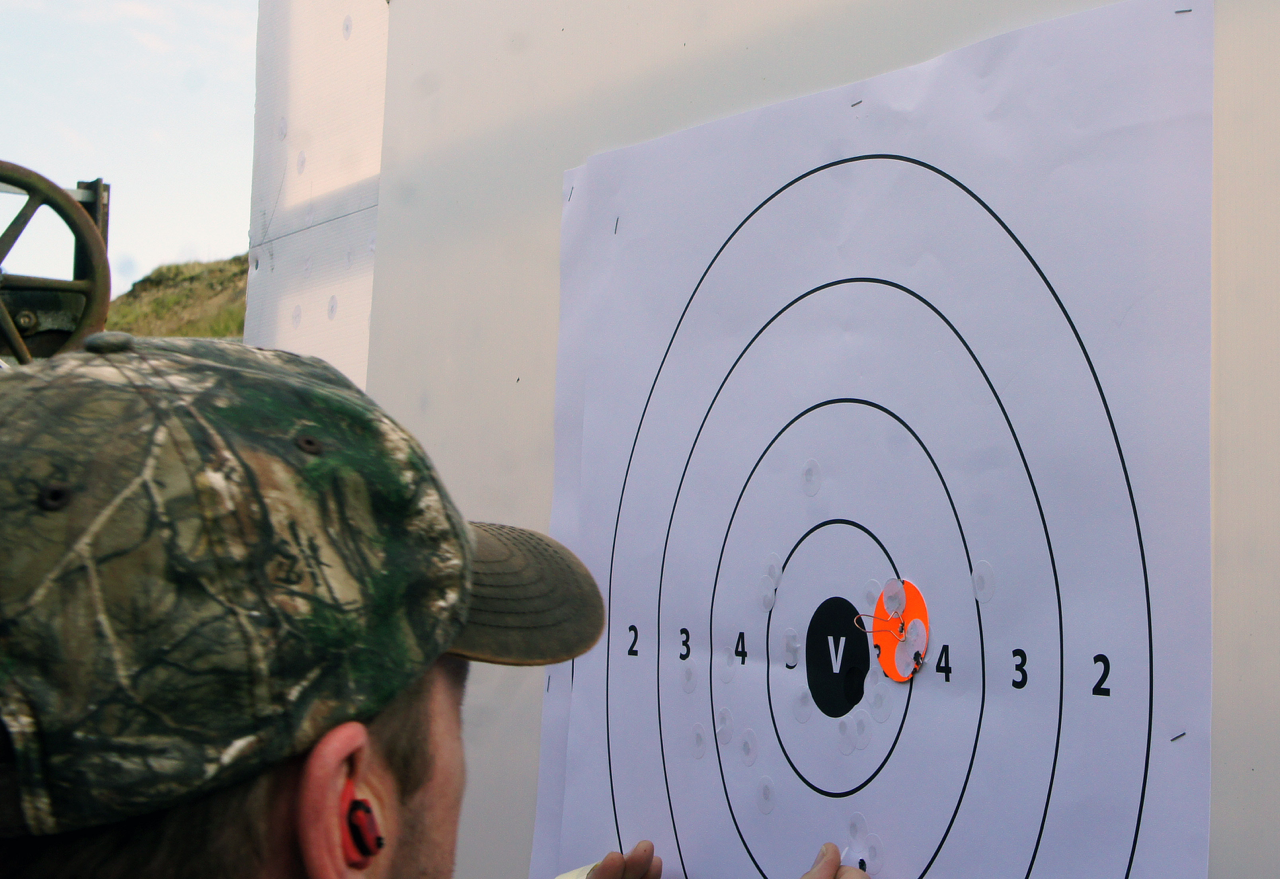
The 600 yard FTR shooter has just managed to break the line to earn the full five points with good if not perfect elevation. A marginally higher strike would have dropped a point
History
Over a half century ago talented bullet-maker, cartridge designer and experimenter, the late Frank C. Barnes (also the author of Cartridges of the World) took the then young 7.62x51mm/308 Winchester and, with some serious reforming, trimming and annealing turned it into the 308×1.5 inch wildcat, originally slated as a light deer cartridge. By pushing the shoulder back around a half-inch and reducing the case length by a similar mount, its capacity was reduced by a third to produce an efficient little number that gave a 150gn bullet 2500 fps MV with good accuracy and light recoil.
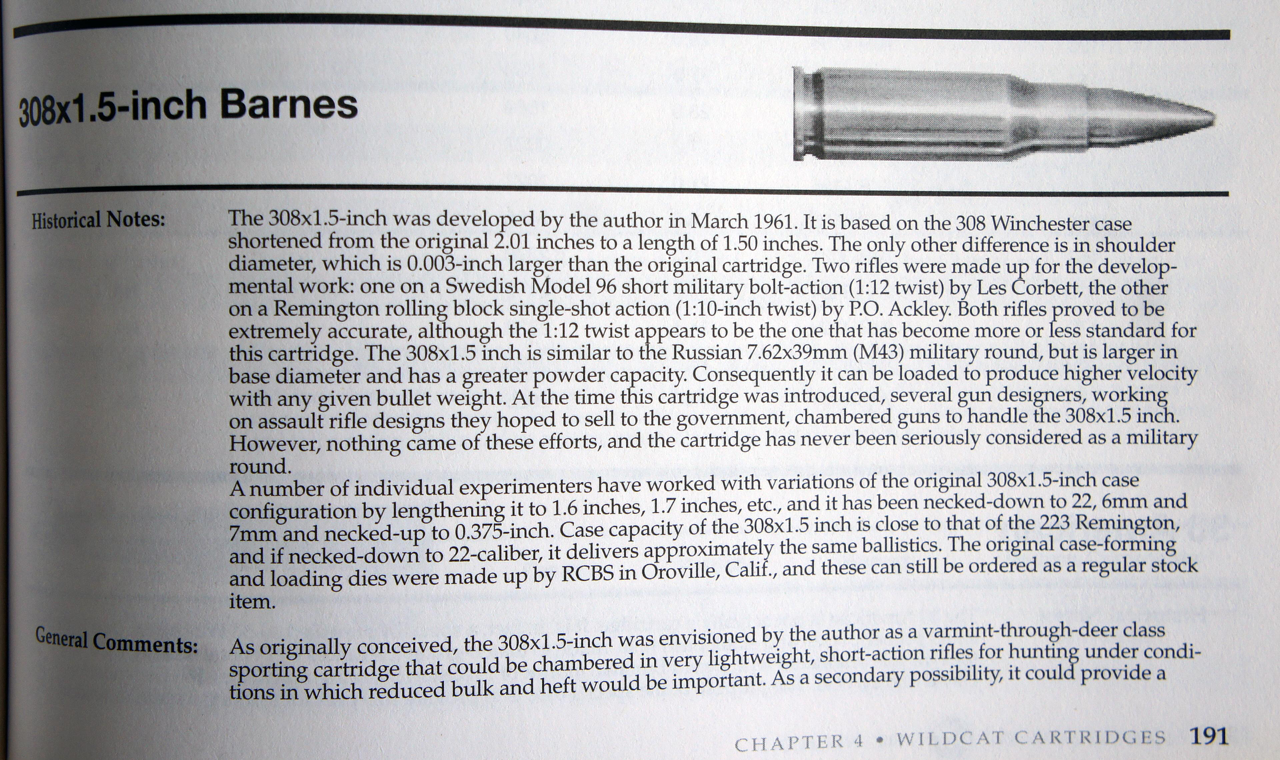
Frank Barnes’ .308X1.5-Inch experimental light sporting rifle cartridge …..
Another brilliant man who happened to hold a key position in the American firearms industry, Remington Arms’ chief engineer and designer, Merle ‘Mike’ Walker (1912-2013), saw potential in Barnes’ little experimental cartridge. He developed it into the BR Remington design, the parent of today’s 6mm BR Norma and other BRs. Among other improvements, it got a longer neck, steeper shoulder angle and the 308×1.5 inch’s large primer was replaced by the small variety. Crucially, the industry norm 2mm (0.079”) diameter flash-hole was reduced to 1.5mm (0.059”).
Remington didn’t produce any 6mm or 7mm BR brass or ammunition though, instead offering a high quality, very thin walled, small primer/flash-hole 308 Winchester case, the 308 UBBR (Unformed Basic BR). Would-be BR users then reformed it into whatever version of the cartridge they desired. However, American Fullbore and Palma shooters, not to mention the usual collection of wildcatters, also liked what they saw with the former group envisaging the case as an enhanced capacity 308 Win with improved ignition characteristics thanks to the use of SR primers.
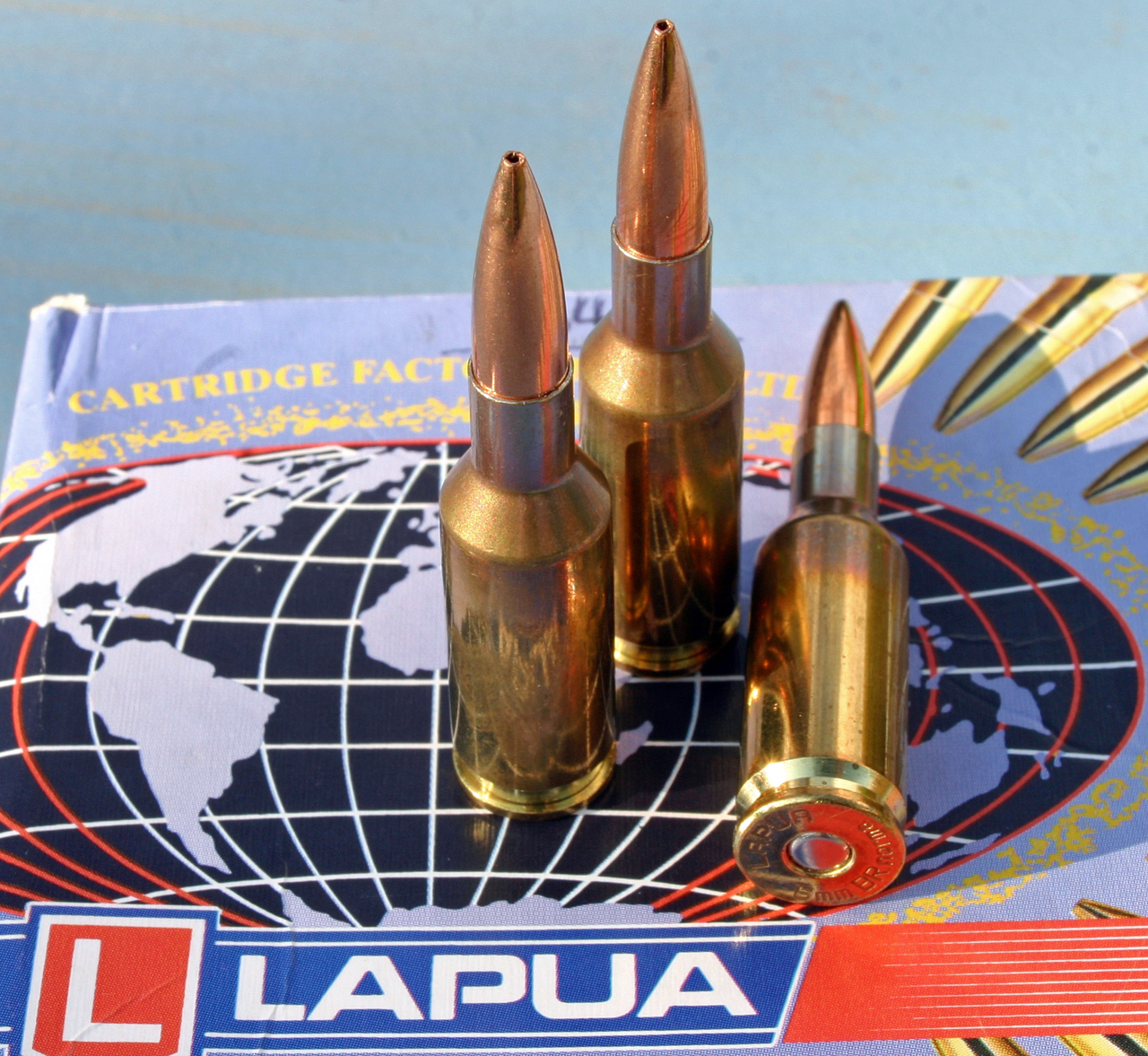
…. became the 6mm BR seen here in its revised ‘Norma’ form, but also saw the first full size SRP 308 Win case
This was sometime around the late 1970s, so we had a prototype 308 Win ‘Palma’ case 40 years ago? Well, yes and no. Yes in that there was specialist brass available which some shooters loaded and shot as the parent 308. No, given its super-thin construction the Remington UBBR product had more internal capacity than today’s Lapua ‘Palma’, likely enough difference to affect behaviours. Most of those who used it in 308 Win guise complained of inconsistent performance, even suffering hang and misfires; some said it only ‘worked’ with flash-holes drilled out to the standard 0.080” size. In any event, it didn’t catch on with most experimenters and not at all with ammunition manufacturers.

The now rare Remington 308 ‘Basic BR’ brass was the original SRP version – but it didn’t perform well 40 years ago
Remington to Lapua
The consensus was that UBBR brass didn’t work satisfactorily in its out of the box form because SR primers weren’t powerful enough to ignite 50gn charges of medium burning rate powders reliably, the tendency aggravated by the primer flame and column of incandescent eject material being restricted and narrowed by the small diameter flash-hole. So, whilst the various calibre BRs with their 30gn charges eventually ‘came good’, the small primer 308 Winchester apparently proved a step too far or in this case a step or three too big.
Not everybody accepted the consensus. Tom Whitaker, one of America’s most successful long-range sling and Palma shooters thought otherwise, moreover coming onto the scene some years later made UBBR based 308 loads work. In fact they eventually worked so well that Lapua was impressed and when the US Palma Teams asked if it would make some experimental 308 small primer cases the company agreed. Some 1000 examples were quietly provided to American Palma shooters for the 2009 season and no doubt Lapua retained others for in-house testing.
Approaching Nammo Lapua Oy was a logical step for the Americans. Not only had they switched from Winchester to Lapua cases some years earlier but the Finnish company already had two highly regarded small primer/flash-hole cases in production that use the same 0.473” head diameter and rim/groove arrangement as the 308 Winchester – the 6mmBR Norma and the more recently introduced 6.5x47mm Lapua. It was relatively easy for production engineers to divert some 308 cases during the case-head forming steps onto one of the other lines.
Sheets of Flame
After a year of load development and testing various components from the bench in different conditions alongside long-range matches on American ranges to obtain ‘real life results’, the Palma Teams’ officials were satisfied that Lapua’s SRP 308 brass ‘worked’, moreover delivered the promised long-range benefits. Compared to standard Lapua LRP brass, MV spreads were reduced by a third, precision was at least as good. Lessons were learned, primarily to use BR or Magnum primers; charges needed to be a little higher to get the same MVs.
So, when Dan Simpson went public on the ‘US Teams’ Long Range Forum’ over the winter of 2009/10 giving the ‘good news’ about this improvement, notice that Lapua was putting the case into production for general distribution and sale during 2010, and that the official US Palma touring team would use ammunition in these cases in the 2011 fixture to be held in Australia, you’d have thought this news would been welcomed. What is it Ralph Waldo Emerson is usually attributed as saying? Build a better mousetrap, and the world will beat a path to your door. That response might have been a bit much to expect but I imagine Dan and his fellow team managers were taken aback by the sheets of flame, even overt hostility that broke out.
The primary criticism was on the lines of: been there, done it …. and It does not work .. not then .. not now .. not ever! (From those with experience of the old Remington UBBR case.) Then … it’s not compliant with SAAMI 308 Win specifications, so ICFRA (the fullbore shooting disciplines’ regulating body) will disqualify anybody using it. …. other teams will be unfairly disadvantaged. …. everybody will have to change their rifle actions or have them modified with smaller diameter firing-pins (the primer ‘blanking’ issue) and on, and on …….!
Strong
In response, we now know that it definitely does ‘work’. (Exactly what had changed over the intervening years between the 70s and the Millennium is questionable but something apparently had). SAAMI doesn’t specify primer size, type or flash-hole diameters for any cartridge, so one cannot be ‘non-compliant’ in the absence of a standard to comply with. ICFRA was relaxed about the issue. Lapua would put the cases on general sale during 2010, so playing fields were level.
There is something in the firing-pin/blanking issue that I look at below but it’s not significant in any of the ICFRA disciplines as 99% of high-level competitors use Barnard, Borden, RPA, Stolle, BAT and suchlike actions which cope happily with small primers. There is another significant plus to these cases for the handloader which either wasn’t recognized seven years ago, or if so didn’t attract any comment – they are very strong. Whilst FTR competitors were routinely scrapping standard Lapua brass after four or five firings with full-pressure loads back in 2009/10, (fewer firings for Winchester examples), due to case-head/primer-pocket expansion, ‘Palma’ brass was to prove unaffected by the same pressures and will regularly stand up to double-figure loadings/firings.
The benefits of the small primer/flash-hole set-up are so accepted these days that Lapua now makes no fewer than six models incorporating it – 220 Russian, 6mm BR, 6.5mm Grendel, 6.5x47mm Lapua, 6.5mm Hornady Creedmoor, and of course 308 Winchester (‘Palma’ option). Moreover, many seekers after precision take these cases and reform and/or fireform them into yet more designs where a factory SRP option isn’t available. (I do it for 7mm-08 by necking 308 ‘Palma’ cases down with excellent results.) After nearly 10 years, we are beginning to see other cartridge companies adopt it too, Peterson Cartridge Co. listing small primer 308 Win.
Rifle and Loads
So, onto the tests. As with the previous LRP trial, a 308 Win FTR rifle was used. This time round it was one built by Osprey Rifles for the 2013 F-Class World Championships in Raton and is a superb performer. The specification is a Stolle Atlas action (a Remington 700 profile, single-shot, non-ejector, twin-lug FTR design); Broughton 10-twist Heavy Palma profile 32-inch barrel; Joe West laminated timber FTR stock (a really comfortable and superbly stable design using a very long forend); Tier-One rail and mounts holding a Sightron Series III 8-32X56 LRMOA ‘scope.
In FTR guise, I use either a Dan Pohlabel FLEX-Bipod or the SEB Joy-Pod with a very heavy and stiff rear-bag. For the tests, a Fox Firearms front-rest riding plate was fitted to the accessory-rail for rested shooting off the bench. With my standard match loads (155.5gn Berger BT/IMR-8208 XBR or 168gn Berger Hybrid/Reload Swiss RS52, both in ‘Palma’ brass with the CCI-BR4 primer) it will average under a third-MOA over several 100 yard groups off the bench and produce the occasional one on or under 0.2-MOA as well as holding good elevations to 1000 yards.
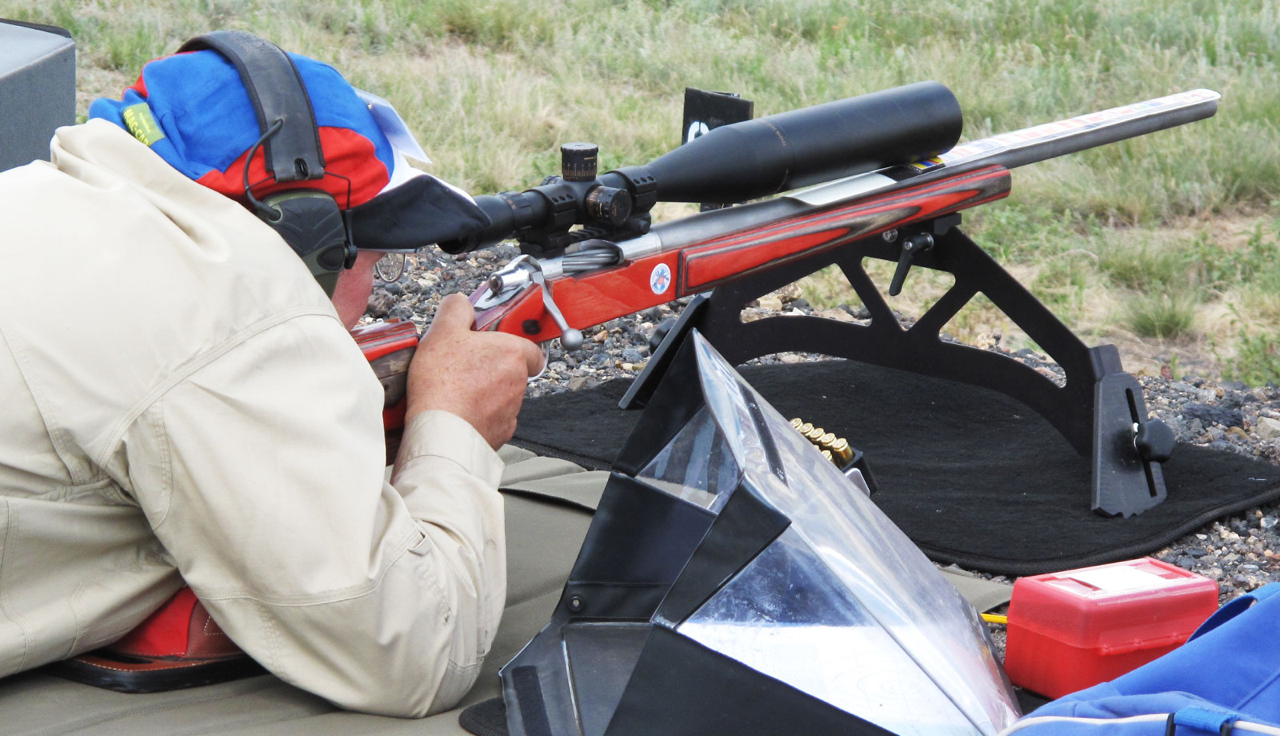
The rifle used in the tests at the 2013 F-Class World Championships in Raton USA
The test load utilised 100 twice fired ‘Palma’ cases from this rifle that had been used with the 155.5gn Berger/8208-XBR load; 300 plus Lapua 167gn Scenar match bullets; an unopened 1Kg bottle of Vihtavuori N150 that was six or seven years old but had been stored in cool, dry conditions …. and of course a selection of SR primers.
The brass had been mildly ‘prepped’ when new – a ‘clean up’ neck-turn that reduced thickness from 0.0148 – 0.0155” values to 0.0144/5”; weight batched; flash-holes reamed with a Sinclair ‘uniforming’ tool. The last is controversial – many Lapua small flash-hole case users won’t touch them as opening them out significantly invites increased velocity spreads and group dispersions. However, Sinclair and K&M uniformers only do so marginally, from a nominal 0.0590” to 0.0625”. In practice, it’s rarely as much as that, as ex-factory hole diameters are often in the 0.060/061” range. In my experience with 308 ‘Palma’ cases, the Sinclair tool barely kisses 90% plus of flash-hole walls, but a small number of cases need more effort and several turns of the cutter showing their flash-holes have a significantly smaller diameter than the norm, maybe even under the nominal size.
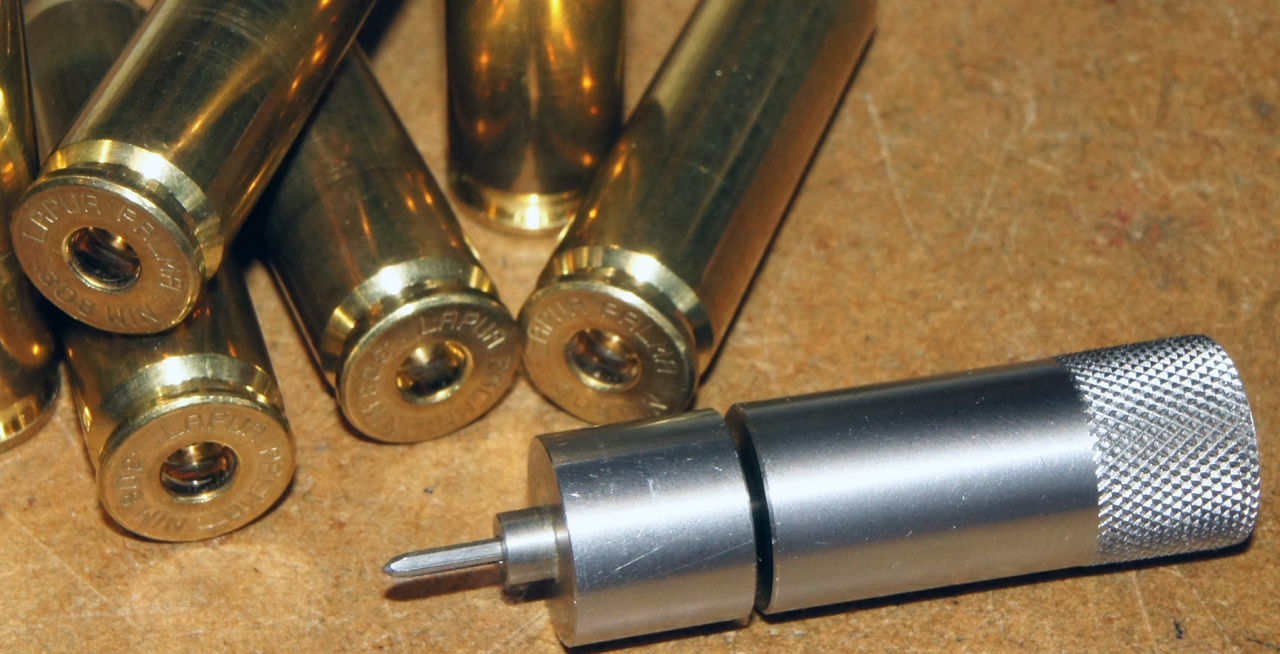
‘Palma’ cases and the Sinclair 1.5mm flash-hole ‘uniformer’
Tools and Processes
Necks and shoulders were annealed before each loading as part of a striving for consistency, not that I believe that this is 100% necessary. The brass was sized and primed as per my usual practices for match ammunition. Case necks were cleaned of fouling on the outside and vigorously brushed inside leaving a thin carbon coating. Both inside and exterior neck surfaces were lubed and the case sized with a Forster Bushing-Bump neck-sizer die with a bushing around a thou’ smaller than needed and the neck was then re-expanded marginally using a Sinclair E30 mandrel.
The Forster die ‘bumps’ the case-shoulders in addition to sizing the neck and is supplied without an expander-ball being intended for use on neck-turned brass. I’ve found that pushing the shoulders back by 0.001-0.002” from the fired position (as measured using a Hornady comparator tool and case ‘headspace’ gauge) not only gives good results but hasn’t shown up any need for full-length body sizing to date, cases still chambering and extracting without any ‘tightness’ at all, some after eight or nine firings.
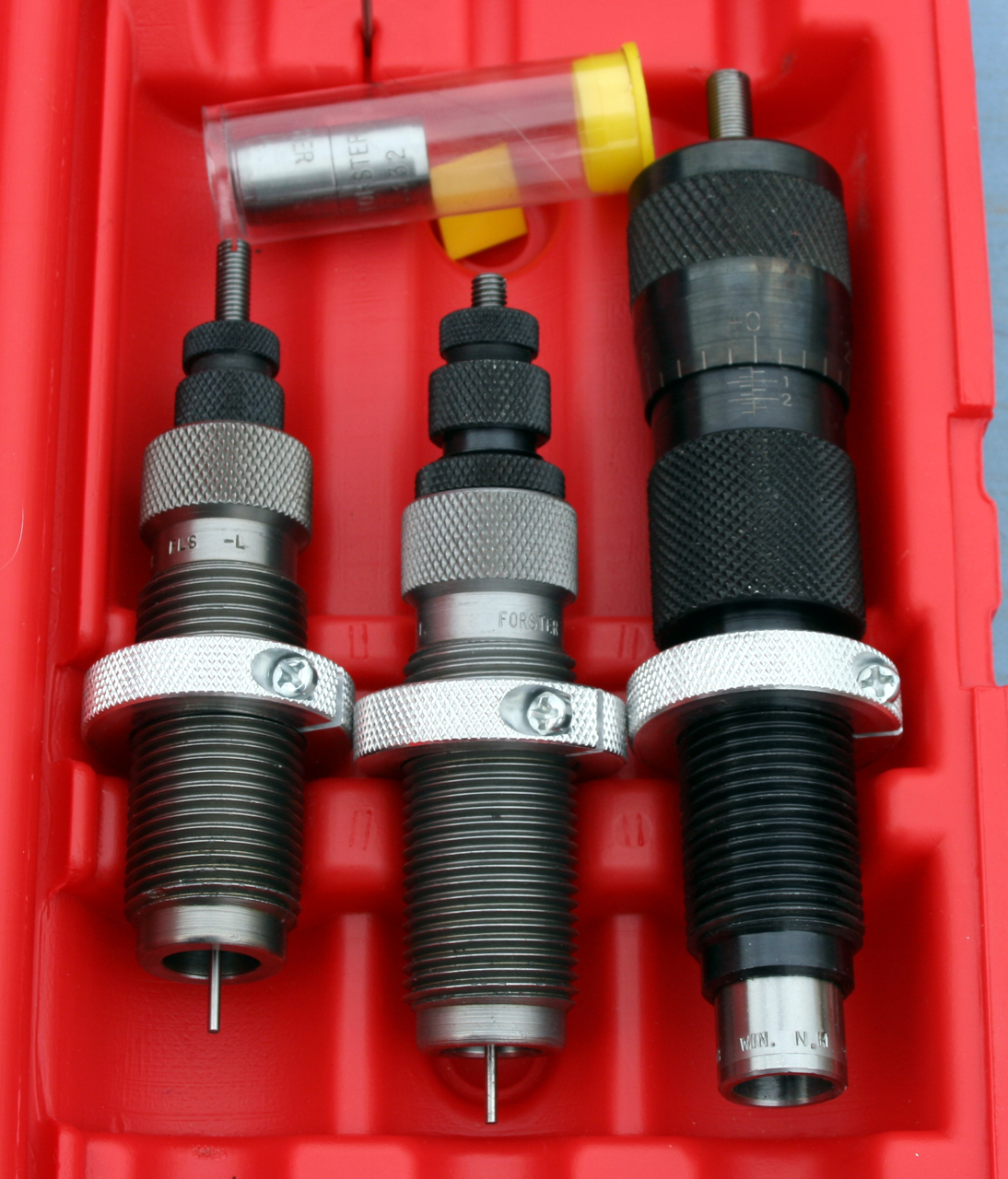
Forster dies. Left to right: standard full-length sizer; Bushing-Bump sizer; ‘Ultra’ seater
I’ll put priming and primers off to the next part of this story, so let’s talk bullets. That used was the antediluvian 167gn Lapua Scenar – an excellent short/mid-range model but with a low BC compared to those preferred in long-range FTR these days (Bryan Litz measured G7 BC of 0.216 compared to 0.265 for the much younger 168gn Berger Hybrid or even the 155.5gn Berger BT Fullbore’s 0.237). I already had the 300 plus examples needed in stock and Lapua makes high quality, consistent products. In fact, I’d decided to do a BTO (base to ogive) measurement and weight batching exercise on the bullets to match the use of ‘prepped’ brass but gave up after measuring/weighing 50 examples such was their consistency. The COAL with the bullet 15 thou’ off the lands was ascertained and bullets were seated with another Forster die, the ‘Ultra’ seater model with its micrometer top. All loaded rounds were measured with a Hornady comparator set-up and had the same case-head to bullet ogive measurement plus or minus 0.001” – the standard I seek to achieve in my long-range match cartridges.
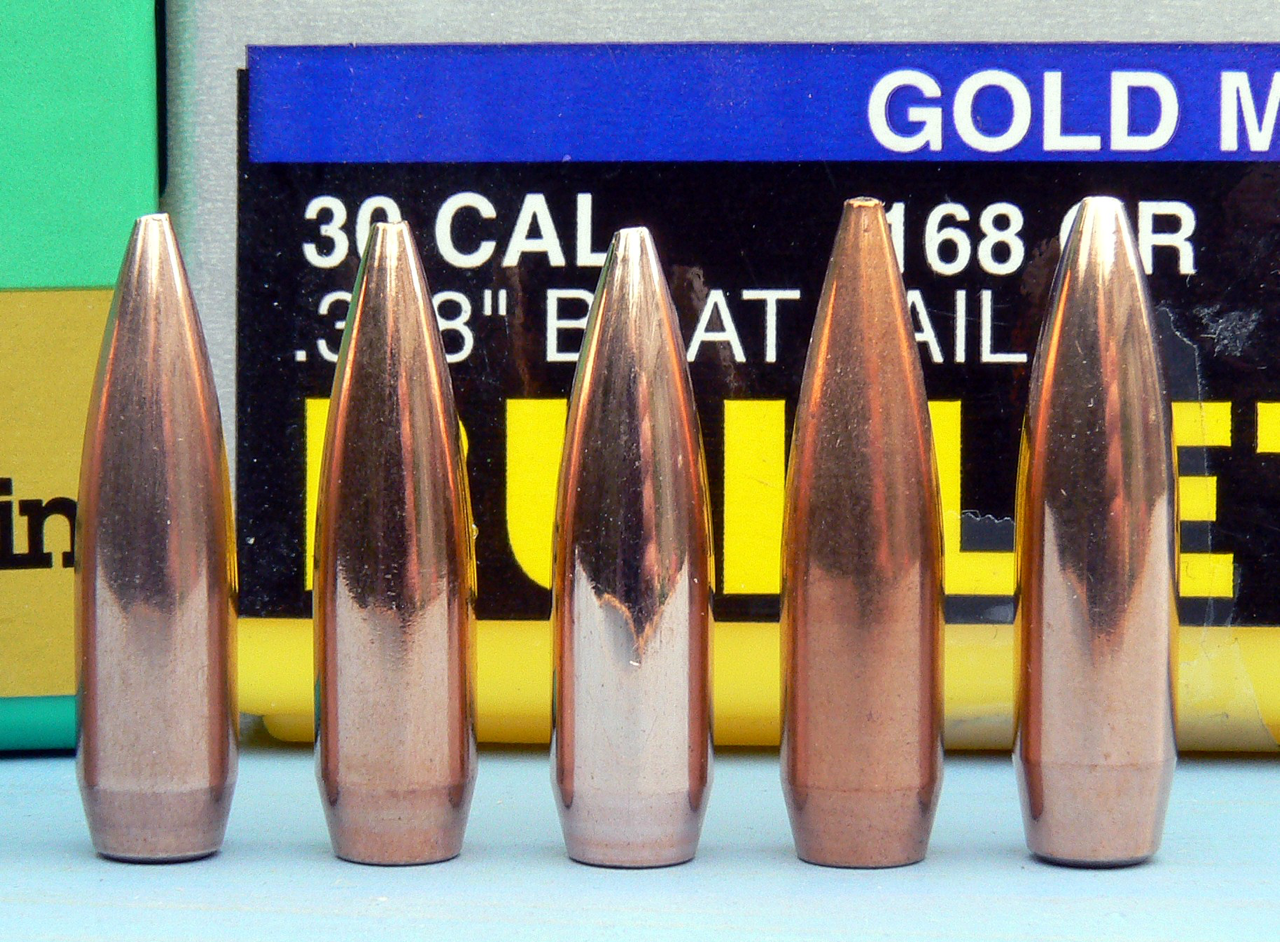
A quintet of older generation low-BC 0.30 168gn match bullets. The 167gn Lapua Scenar (far right) is a blunt-nose design even in this company.
Finally, single-based Vihtavuori N150 was used as the propellant, a slowish burner for the 308 Win but suited to the 167gn bullet and which has given me good results over many years in this cartridge with bullet weights from 155gn up to 190gn. Charges were dispensed on an RCBS Charge Master then adjusted if necessary to be plus or minus 0.04gn of the desired charge on weighing on a set of Acculab VIC123 laboratory quality electronic scales. (0.04gn = two N150 powder kernels.)

